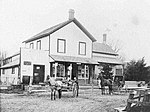MacMillan Yard

MacMillan Yard is the main Toronto-area railway classification yard for Canadian National Railway (CN), and is located in the nearby suburb of Vaughan, Ontario. It is the 2nd largest railway classification yard in Canada, after CN's Symington Yard in Winnipeg. It was originally opened in 1965 as Toronto Yard, but was renamed MacMillan Yard in 1975 after former CN president Norman John MacMillan. MacMillan Yard is located at the junction of the CN York Subdivision and CN Halton Subdivision, spanning the area around the communities of Maple and Concord. The yard measures approximately 3 kilometres in length and 1 kilometre in width, with a north–south orientation. The property is bordered by four main roads: Highway 7 (York Regional Road 7) to the south Keele Street to the east Rutherford Road (Regional Road 73) to the north Jane Street to the westThere are five road entrances into the yard which are designated as: S Yard, Jane Street, CargoFlo, Bowes, and Administration. The yard was developed in the late 1950s as part of CN's redesign of its Toronto trackage network: their "Toronto bypass" project, that moved freight traffic out of the busy downtown Toronto and surrounding area to a new modern freight yard north of the city, accessed by both newly constructed and upgraded railway lines. The first revenue train arrived in the yard on February 6, 1965, but the yard's official opening was on May 17, 1965. Much of CN's freight operations that were once located in Toronto proper (notably at Mimico Yard) were moved to the new yard. The project also freed up track time along CN's downtown rail corridors that allowed the Government of Ontario to establish a new commuter service, GO Transit. Much of the yard is composed of side-by-side track, switches, humps, and control tower buildings. The yard is designed to take incoming trains and reorganize and rejoin the individual cars based on destination to create new departing trains. The yard operates 24 hours a day and handles over 1 million cars (loads and empties) per year. It has flat switching capability as well as both dual and single humps. In addition to car handling, other yard facilities include locomotive repair, car washing, and car repair. In one part of the yard, a CargoFlo terminal is used for transferring flowable bulk, dry bulk (plastics) commodities between rail cars to tanker trucks, as well as a small intermodal and RoadRailer operation. At the time of construction, Vaughan (then known as Vaughan Township) was a largely rural community; however, subsequent development on adjacent properties has created an industrial area surrounded by a variety of industrial consignors, distributors, and suppliers. Some commercial establishments (e.g., restaurants, retail and wholesale outlets) are located along the perimeter of the yard. Several York Region Transit routes, including Viva Orange, operate in the vicinity of the yard; most connect to the northern terminus of the Toronto Transit Commission's Line 1 Yonge-University subway line, but one connects to Rutherford GO Station The closest residential population to a track that carries dangerous goods is located approximately 150 meters from the northernmost extension of the yard near Jane Street. At the southern end of the yard, where several rail lines merge, Highway 7 provides a road bridge. Highway 407 also bridges the southern entry point to MacMillan Yard; all trains enter and exit by way of southern end. Rutherford Road passes over the hump pullback tracks at the north end of the yard. Construction of the yard resulted in Langstaff Road being bisected by the yard, but plans have been floated by York Region to construct a bridge over the yard to reconnect the two sections.
Excerpt from the Wikipedia article MacMillan Yard (License: CC BY-SA 3.0, Authors, Images).MacMillan Yard
Bowes Road, Vaughan
Geographical coordinates (GPS) Address External links Nearby Places Show on map
Geographical coordinates (GPS)
| Latitude | Longitude |
|---|---|
| N 43.812 ° | E -79.511 ° |
Address
CN MacMillan Yard
Bowes Road
L4K 1G6 Vaughan
Ontario, Canada
Open on Google Maps









